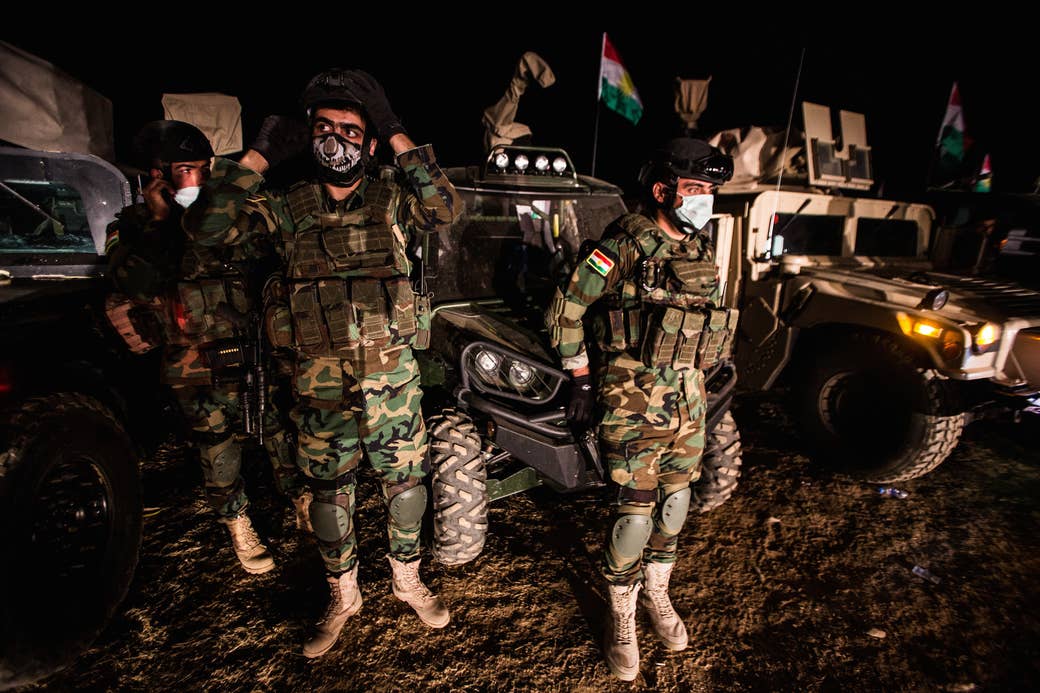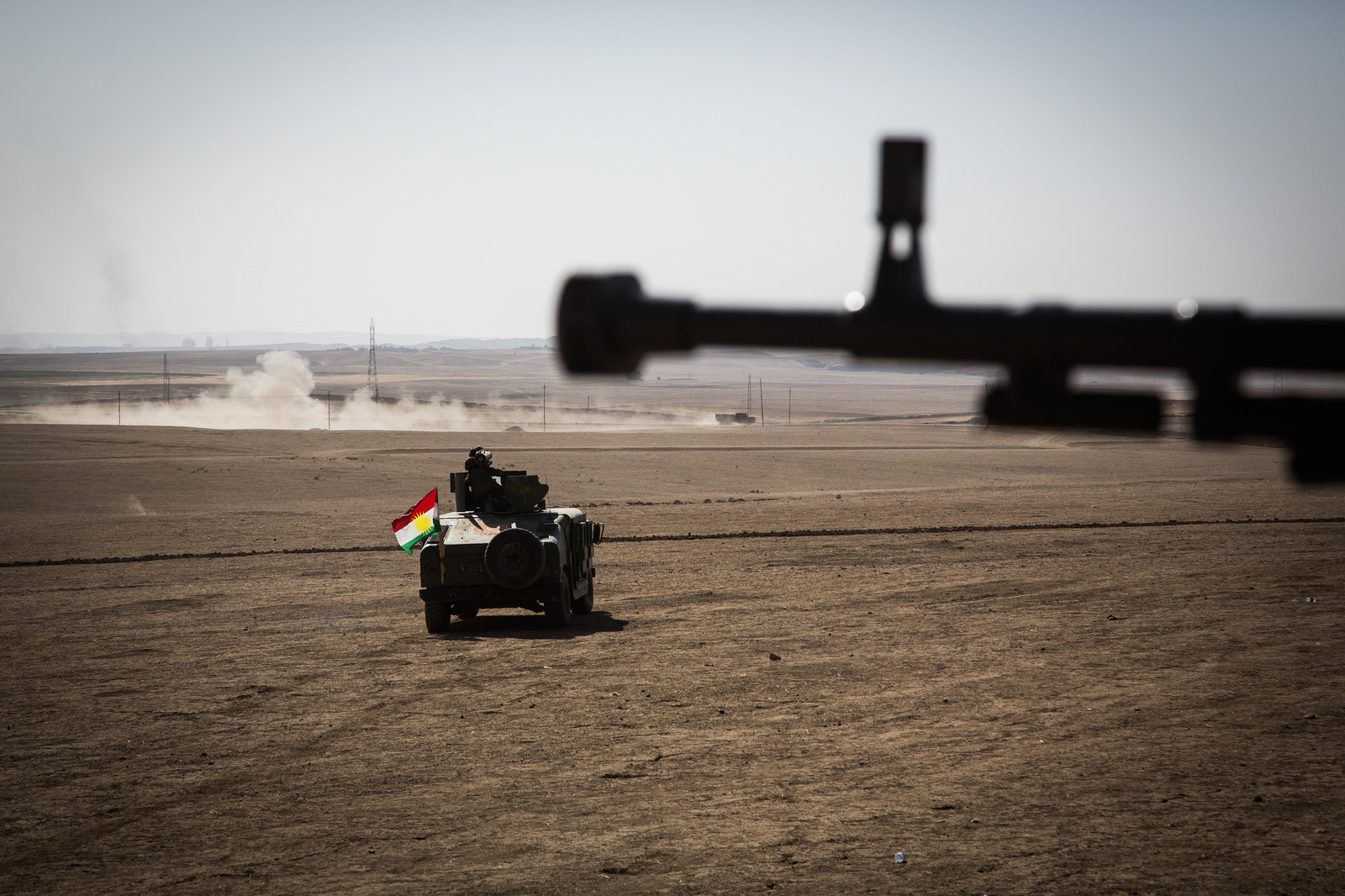
FEL FEL, Iraq — The ISIS bomb crashed into a group of soldiers with a burst of shrapnel and a metallic surge of heat, and the sound of moaning filled the air.
Some men scrambled for cover inside US-made armored Humvees. Others rushed to tend to their wounded colleagues. An injured soldier wandered in a daze through the settling dust, blood dripping from a gash on his head. Another was carried from the blast site with one foot severed and the opposite leg in shreds. A third, a hole slashed across his stomach, was bleeding to death.
The start of the Mosul offensive this week was marked by official announcements and a well-orchestrated media campaign. Quick initial advances brought expectations for quick success. One week in, those expectations have now clashed with the reality of a bloody struggle ahead. The Iraqi military and Kurdish peshmerga, the two main forces fighting ISIS, suffered mounting casualties as assaults were bogged down in the face of stubborn resistance from the militants. A US service member assisting with the Mosul operation was killed by an IED on Thursday. At least two local journalists have been killed, and a New York Times photographer was hospitalized after suffering shrapnel wounds from a suicide car bomb.
ISIS launched a surprise attack in the Kurdish-controlled city of Kirkuk on Friday, and on Saturday, the militants torched a sulfur field south of Mosul, sending a toxic cloud of smoke hurtling toward the nearby US base at Qayyarah as US soldiers donned protective masks.

A bold assault launched by one of Iraq’s elite anti-ISIS forces on Thursday offered a window into the unfolding chaos. As its troops opened Mosul’s northern front with a push deep into ISIS territory, they faced a barrage of suicide car bombs, heavy machine-gun fire, and IEDs, along with constant mortar attacks — including the blast that hit three soldiers at a makeshift base.
Their mission was to drive a wedge down from Kurdish front lines into ISIS’s defenses while facing the militants from the south, east and west. The soldiers — members of a specialized force called the Counter-Terrorism Unit (CTU) from Iraq’s semiautonomous Kurdish region — are some of the best in Iraq. Parts of the CTU work closely with US special operations forces, who have trained many of its soldiers and sometimes accompanied them to battle ISIS on the ground. A reporter and photographer from BuzzFeed News were the first foreign journalists permitted to embed with the secretive unit.
The CTU assault began just after dawn when a convoy of armored vehicles rolled through a gap in the dirt barricades outside a town called Tel Asqaf that for months had marked the Kurdish front lines. The convoy crept like a slow-moving snake through fields of sun-burnt grass, waiting patiently as technicians in an armor-plated tractor swept the ground for IEDs, which ISIS has deployed in unprecedented numbers. Plumes of dirt shot into the air as the devices were safely detonated.

In the convoy’s eighth vehicle, a 33-year-old captain with a confident expression and maroon beret surveyed the landscape from the open air atop the turret of his Humvee. The captain, who for security reasons can be identified only by his first name, Saeed, was manning a sophisticated anti-tank weapon mounted to the turret, used to shoot guided missiles at the ISIS weapon the soldiers on the convoy most feared: suicide car and truck bombs. As the Humvee inched ahead, the turret creaked slowly as he turned a hand-crank to rotate it from side to side.
ISIS sometimes sends car bombs straight at Capt. Saeed, hoping to neutralize the convoy’s defenses. The militants were successful once, he said, ramming his Humvee and detonating a blast that sent it two stories into the air. One soldier in the Humvee was killed and Capt. Saeed was rushed to the emergency room, but he left the hospital to return to his unit the same day. The US-trained officer — who said he had accompanied US commandos on joint operations — considered it an honor to fight ISIS and even to die if it meant driving the militants from Kurdish land. “To die for a goal that big is worth it,” he said. “All of us have considered the day that we’re going to be killed.”
Mortar rounds, fired by ISIS militants in the distance, began to thud into the dirt around the convoy. Fighter jets from the US-led coalition launched airstrikes targeting the mortar teams in reply, and at times it felt like the convoy was serving as bait to draw out ISIS positions in the fields and villages nearby. A team of US troops known as forward air controllers traveled near the rear of the convoy to assist with calling in the strikes, as such teams have in support of operations throughout the Mosul offensive, a Kurdish official said.
The convoy rolled past a small cluster of tents and trucks where farmers were tending to livestock as two teenaged boys vigorously waved white flags. Inside the Humvee, the driver and two soldiers working as spotters kept an anxious watch out their bulletproof windows, straining to see if any of the vehicles in the distance were moving.

Soon gunfire began to hit around the convoy, coming from a compound of buildings less than a mile away. A sound like the chirping of birds signaled that bullets from a mounted machine gun were flying around Capt. Saeed’s head. Dust rose up inside the Humvee when one of the bullets smacked into its side. The convoy erupted in noise as its own heavy guns returned fire. Then frantic calls began sounding on the Humvee’s radio: An armor-plated truck bomb was speeding the convoy’s way. The spotters shouted to Capt. Saeed in a panic as he cranked the turret’s handle and faced his weapon toward the vehicle, which was trailing a cloud of dust through the fields as it picked up velocity. The spotters threw off their helmets and put on noise-canceling earmuffs, and a lightning crack echoed inside the Humvee as Capt. Saeed fired. Then an explosion rocked the Humvee as the missile hit the truck bomb, leaving a geyser of grey smoke in its place. The spotters erupted in cheers and high fives, and then they rushed out of the vehicle to load the next missile.
The vehicle bomb was one of three the convoy would detonate that day. By late afternoon, with the ISIS positions in the compound largely destroyed, a team of cranes and bulldozers appeared behind the convoy and began pushing up dirt barricades for a makeshift base. The CTU had advanced to some seven miles from the outskirts of Mosul, near the village of Fel Fel. As the tired troops disembarked from their vehicles, though, they learned that the danger was far from past, as mortars rained down until nightfall and then began again with sunrise the next day. With the bombs falling, some soldiers put on surgical masks, fearing a crude chemical attack. “We’re surrounded by ISIS on all sides,” one said.
As the battle lines approach Mosul, forces like the CTU promise to play an increasing role. Though Kurdish soldiers will soon wrap up their major operations, the CTU will likely feature in special missions alongside Western commandos against ISIS leaders and other sensitive targets, said Michael Knights, an Iraq specialist tracking the conflict at the Washington Institute for Near East Policy. The Iraqi military’s own special forces — who are likewise trained by US troops and work closely with the US military — are meanwhile expecting to lead the block-by-block fighting into the center of the city. “We do the missions that other forces can’t,” said another CTU officer who helped to lead Thursday’s assault.
But Thursday’s fighting was also a preview of how even the best-trained and -equipped forces can find themselves bogged down in the face of committed ISIS resistance. The militants — who were outgunned and relatively small in number but entrenched in defensive positions — managed to slow the planned Kurdish advance. And the battlefield will tilt in ISIS’s favor as it approaches the city, where ISIS, concentrated in higher numbers and with better defenses, will take cover among an estimated 1 million civilians from artillery and airstrikes. “It’s not easy,” said Omar Salem, 23-year-old CTU soldier. “There’s no space for failure.”

